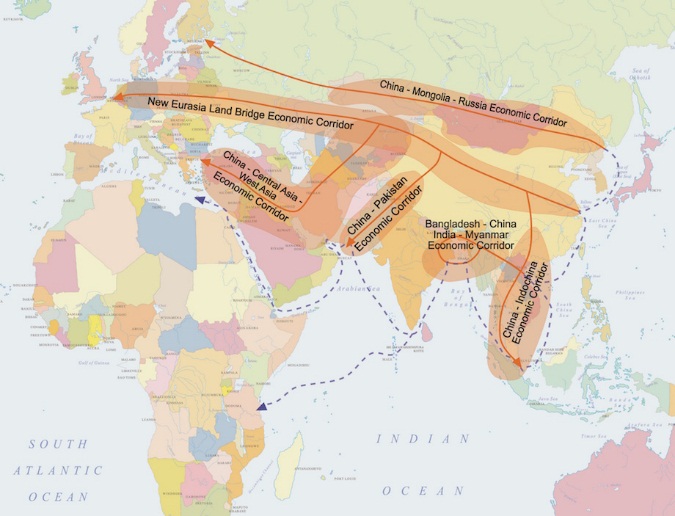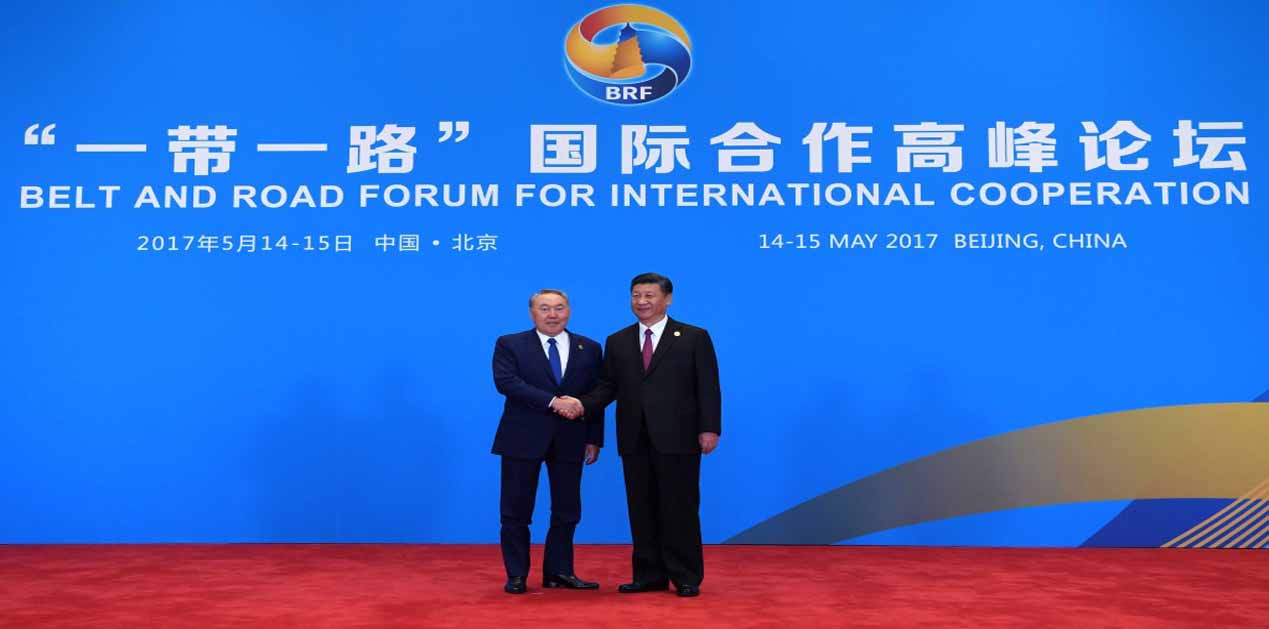The Belt and Road Forum (BRF) sought attention of the international community and made headlines everywhere in mid-May. The event was organized by China in Beijing on 14-15 May 2017 with the purpose of promoting its ambitious project called the Belt and Road Initiative (BRI). This Forum was attended by delegates from over 130 countries and 70 international organizations. Highlight of the event was participation of 29 Heads of States or Governments, representing their respective countries from Asia, Europe, Africa and South America. Several multilateral and bilateral documents were signed on this occasion, including the Joint Communiqué of the Leaders Roundtable.
Out of the five Central Asian Republics (CARs), three sent high-level delegations to the event. President Nursultan Nazarbayev of Kazakhstan, President Almazbek Atambayev of the Kyrgyz Republic and President Shavkat Mirziyoyev of Uzbekistan marked their presence in the BRF. They participated in the Leaders Roundtable, and signed the Joint Communiqué. Interestingly, remaining two CARs of Turkmenistan and Tajikistan chose not to send any high-level delegation to participate in the forum. This article attempts to analyze the significance of CARs in development of the BRI. It also highlights some of the implications of the projects on these landlocked republics.
The Belt and Road Initiative

Belt and Road Initiative is the flagship programme of Chinese President Xi Jinping, covering arenas like transport, connectivity, infrastructure, trade, investments and people-to-people contacts. BRI comprises of the land-based ‘Silk Road Economic Belt’ (SREB) and the sea-going ‘21st Century Maritime Silk Road’, which were announced by Xi Jinping in 2013, in Astana and Jakarta respectively. BRI claims to touch as many as 60 countries and about 63 percent of world population. It envisions to connect China with Europe, West Asia, Central Asia, South Asia, South East Asiai, and further with Africa and South America. Major focus is on building rail and road networks, sea routes and energy pipelines, which will eventually enhance business and trade. Under BRI, six economic corridors are proposed to be developed:-
1. New Eurasian Land Bridge, which connects China and Europe via Central Asia;
2. China- Mongolia- Russia Corridor;
3. China- Central Asia- West Asia Corridor;
4. China- Indochina Peninsula Corridor;
5. China- Pakistan Economic Corridor (CPEC);
6. Bangladesh- China- India- Myanmar (BCIM) Corridor.
BRI is based on multiple objectives, intrinsic as well as extrinsic. From its outlook, it appears to be a multi-lateral project, which is proposed by China and backed by many others. It is set to enhance connectivity, transport, communication, trade and cooperation between different countries and peoples. It is also likely to reinvigorate seamless flow of capital, goods and services between various parts of the world, and to further promote market integration. In the Joint Communiqué that was signed by 30 heads of states/ governments at the end of the BRF, it is stated that the BRI shall be based on principles of peace, cooperation, equality and mutual benefit. It further adds that dialogue and consultation shall be pursued in order to build synergies in development strategiesii.
However, extrinsic objectives of the initiator of the project also need to be seen. China’s multi-billion project is certainly not free from its own geo-strategic, economic and political interests. Firstly, it is trying to exert dominance over smaller and least-developed neighbors through this strategy. These countries are looking at BRI as an opportunity to develop transport and infrastructure and to integrate into global market. But, they are equally conscious about the high amounts of Chinese loans and their trade deficit vis-à-vis China. Secondly, China is trying to export its excess economic capacity to other countries of the region. For them, BRI is also a chance to seek new markets for their manufactured goodsiii. Lastly, one of the objectives behind the initiative is to develop and stabilize western province of Xinjiang, and thereby to integrate it into the larger Eurasian economy.
Revival of the Silk Road
BRI is based on the concept called the Silk Road, which is reflected in names of both its components. Silk Road refers to the network of trade routes that existed in ancient times between various parts of Asia and Europe. It was called so because silk was the major commodity in this trade, although other goods were traded as well. Although the concept refers to the Road; it did not signify just the transport; in fact, it was a complex multi-directional and multi-dimensional process of ‘exchanges’ of goods, people and ideas. Relevance of the Silk Road was diminished subsequently because of number of factors. Major reason was the rise of sea-borne trade between Europe and Asia. In the 18th and 19th Century, almost whole of the Asian continent was colonized and was divided between various empires like Britain, France, Ottoman and Tsarist Russia. This in turn restricted movement of men and materials. After the Disintegration of Soviet Union in 1991, concept of Silk Road experienced steady revival. By the 1990’s, China rose as the enthusiastic proponent of the concept.
Pertaining to its high economic growth and creation of excess capabilities, China started to look at its small neighbors, as sources of raw materials and markets for their manufactured goods. Moreover, China’s trade with the neighbors required improvement in transport and infrastructure facilities. This gave rise to various initiatives, investments, joint projects between China and these small countries. Transport and connectivity projects had begun, under the pretext of revival of ‘Silk Road’, much before the announcement of BRI in 2013. Notably, BRI was the name given to these already existing initiatives, with addition of many more.
Significance of the Central Asian Republics
Central Asia, as the name suggests, has always enjoyed the position of ‘centrality’ in the Asian and Eurasian landmass. The region physically connects South, West, East and North Asia. Ancient Silk Road also passed through this region, which led to prosperity of cities like Samarkand, Bukhara and Merv. Although significance of the Central Asian region dwindled when it was under the Tsarist, and later the Soviet rule, it was regained as a result of the geographical reconfiguration post-Soviet Disintegration. Importance of the CARs was recognized by the international community after their independence in 1991. This realization led to announcements of multiple connectivity projects in this part of the world, initiated by various international and regional powers. These included International North South Transit Corridor (INSTC) led by India, Iran and Russia; Ashgabat Agreement and Central Asia-Iran-Oman Corridor; US-led initiatives of Turkmenistan-Afghanistan- Pakistan-India (TAPI) pipeline and Central Asia-South Asia power project (CASA-1000), and so on.
Independence, which came to CARs as an unexpected development, put these republics into a dilemma. From being part of a super-power, they were suddenly reduced to small, landlocked states with several economic and social hardships. They also had to go through painful transformation from the state-controlled Soviet economy into the market economy. CARs joined many of the aforementioned projects mainly for two reasons. Firstly, to overcome the phobia of being ‘land-locked’; and secondly, to integrate into the global economic system.
During this era, these states were also going through the realization that they have historically been located at the crossroads of human civilizations; and that they once were part of the wider system of ‘trade and communication’. Terms like ‘bridge’, ‘crossroads’, ‘strategic location’ started to appear in the Central Asian discourses during 1990siv. This was the time, when the concept of Silk Road got revived in CARs.

CARs, China and BRI
Central Asia is extremely important for China for variety of reasons. Firstly, three of the five CARs share border with China. Moreover, there are ethnic-linguistic and religion-cultural links between peoples on both sides of the borders. Secondly, Central Asia can be called China’s gateway to the west. All overland routes going from China to Europe, West Asia or South Asia pass through the CARs. Thirdly, three of the five CARs are rich in hydrocarbon reserves, which is a lifeline of Chinese economy. Fourthly, CARs are economically less developed. This condition is conducive for China, as they supply raw material and energy to China, and buy manufactured goods from them. Lastly, the western province of China, known as ‘Xinjiang Uyghur Autonomous Region’, is comparatively less developed and unstable. Connectivity and trade with the CARs is considered necessary for development and stability of Xinjiang.
On the other hand, CARs are also keen on developing robust relations with China. These countries are sandwiched between two major powers of Russia and China, and do not want to be dominated by either. In this light, their recent closeness with China can be considered as a conscious move to avoid over-dependence on Russia. In Central Asia, Russia and China seem to have worked out an unsaid understanding that Russia will retain its political and military supremacy, whereas China will expand its economic clout. However, this extrinsic understanding is getting blurred as Russia is getting uncomfortable with China’s expanding footprints in CARs.
In last few years, China has emerged as the largest trading partner and the largest source of investments in Central Asia. China’s total trade with the five CARs combined has increased from $1.5 billion in 2001 to $50 billion in 2015. In the same year, their second trading partner Russia was limited to around $31 billionv. Moreover, the country has put enormous money as part of investment, especially in the transport, infrastructure and energy sector. It has been funding or building of roads, railway lines, bridges and tunnel across Central Asia. The three pipelines from CARs take huge amount of energy to China. It owns close to a quarter of Kazakhstan’s oil production and takes almost half of Turkmenistan’s gas exports. Recently they have signed $15 billion gas and uranium deals with Uzbekistanvi.
Chinese President Xi Jinping announced the Silk Road Economic Belt Policy, during his visit to Astana in 2013, in the presence of Kazakh President Nursultan Nazarbayev. This gesture underlines the vitality of Central Asia in developing the BRI. Two of the six economic corridors envisioned under BRI pass through CARs, namely ‘New Eurasian Land Bridge’ that connects China and Europe via Central Asia, and ‘China- Central Asia- West Asia Corridor’. Kazakhstan occupies vital position, as the newly developed high speed railway from China to Europe pass through its territory. Similar construction of rail routes is underway in other republics too. For example, China recently sponsored construction of the Kamchiq tunnel, which connects the Fergana Valley region of Uzbekistan to Tashkent. This tunnel is part of the envisaged China-Kyrgyzstan-Uzbekistan railway line, which will further be expanded up to Iran and West Asia.
After the inception of BRI, CARs announced their enthusiastic active support to the initiative. In fact, most of the Chinese initiatives in Central Asia had begun since end of 1990s, much before announcement of the BRI. According to Pantucci, “..the region served as a conduit for China’s decades-long approach to investment around the world… Beijing’s investments in Central Asia since the end of the Cold War provide a model for the globalised Belt and Road Initiative.” vii. Nonetheless, China’s economic engagements relating to trade, investments and connectivity have increased manifold in last three years. During the BRF, several agreements were signed between China and the CARs, including the following:-
1. Agreement on International Transportation and Strategy Coordination with Uzbekistan;
2. Economic and Trade Cooperation Agreements with Uzbekistan and Tajikistan;
3. Cooperation Plan on promoting Small and Medium Enterprises with Kyrgyzstan;
4. Industrial Capacity and Investment Cooperation with Kyrgyzstan;
5. Customs Cooperation with Kazakhstan;
6. Chinese Participation in “Digital Kazakhstan 2020”;
7. Educational Cooperation with Kazakhstan;
8. Tourism Cooperation with Uzbekistanviii.
From the list of agreements and overall China-CARs partnership within the BRI framework, it can be said that each of the CARs has shown different levels of interest in the project. Kazakhstan and Uzbekistan are enthusiastically engaging with China, whereas participation from the Turkmen side is the lowest amongst CARs. Also, the approach of each republic varies according to its economic and socio-political situation. For example, Kazakhstan, which is economically prosperous and resource-rich, is participating in BRI with a degree of confidence. On the other hand, poor, under-developed republics of Kyrgyzstan and Tajikistan are playing roles of the receivers. Kazakhstan’s own economic program called ‘Nurly Zhol’ix was integrated with BRI in 2016x. This shows the largest CAR’s readiness to actively participate in the project.
Implications of BRI for Central Asia?
As mentioned above, Central Asia occupies a very important position vis-à-vis development of the BRI. In fact, the region has been the first to receive huge sums of Chinese loans, investments and economic support in all arenas. Construction of roads, railways, bridges and tunnels and development of basic infrastructure was the necessity for the young and volatile CARs. Investments, joint ventures and projects in sectors like energy, industry and agriculture have definitely played positive impact on overall economic development in these republics. Moreover, China has emerged not only as a market for Central Asian energy, but also has been active in oil and gas explorations and extraction. Further, projects under BRI have helped CARs to connect with the world, physically and economically.
Nonetheless, there are concerns about BRI and increasing Chinese engagements in CARs. Huge amounts of loans is a serious issue, as this may push these countries into the debt trap. This is specifically true for economically vulnerable countries like Kyrgyzstan and Tajikistan, where more than 40% of their external debts belong to Chinaxi. In 2011, Tajikistan and China signed border demarcation agreement, where the later gained roughly 1 percent of former’s territoryxii. Some observers described it as unofficial ‘debt writing off agreement’ between the two. Central Asian governments and people have also grown apprehensions about the influx of Chinese labor force. While, Turkmenistan and Uzbekistan have put in place laws making employment of local labors mandatory, such laws are absent in Kyrgyzstan and Tajikistan. In these countries, there is more visible Chinese workforce. This gives rise to resentment and discontent as labors from home countries are put out of jobs. Also, locals are suspicious about foreigners who speak different language, leading to unavoidable conflicts.
Most important concern about Chinese investments in CARs is that China might assume role of the security provider to protect its assets. It has already outnumbered powers like Russia, US and European Union in terms of economic penetration. Apart from that, it has also started spreading wings in the political and security arena. Supply of arms and ammunitions to some of the CARs, counter-terrorism cooperation, and recently conducted joint military operations in Tajikistan set the alarming bells ringing. These developments are making CARs as well as Russia uncomfortable.
End Notes:
i. “Belt and Road Basics”, Hong Kong Trade Development Council (HKTDC), (URL: https://beltandroad.hktdc.com/en/belt-and-road-basics).
ii. Joint Communique of the Leaders Roundtable, Official Website of the Belt and Road Forum for International Cooperation, (URL: http://www.beltandroadforum.org/english/n100/2017/0516/c22-423.html).
iii. “A Role for UK Companies in Developing China’s New Initiative: New Opportunities in China and Beyond”, Report by China-Britain Business Council, published in December 2016, (URL: http://www.cbbc.org/cbbc/media/cbbc_media/One-Belt-One-Road-main-body.pdf).
iv. Tolipov, Farkhod, “One Belt, One Road and Many Countries”, China in Central Asia, published on 7 February 2017, (URL: http://chinaincentralasia.com/2017/02/07/one-belt-one-road-and-many-countries/).
v. Muzalevsky, Roman, “China’s Long March into Central Asia”, Stratfor, published on 27 April 2016, (URL: https://www.stratfor.com/article/chinas-long-march-central-asia).
vi. Wilson, William T., “China’s Huge One Belt One Road Initiative, The Heritage Foundation, published on 21 Noivember, 2016, (URL: http://www.heritage.org/asia/commentary/chinas-huge-one-belt-one-road-initiative-sweeping-central-asia).
vii. Pantucci, Raffaello, “China: Understanding Beijing’s Belt and Road Initiative”, China in Central Asia, published on 14 May 2017, (URL:http://chinaincentralasia.com/2017/05/14/china-understanding-beijings-belt-and-road-initiative/
viii. Full Text of the List of Deliverables of the Belt and Road Forum, Xinhuanet, (URL: http://news.xinhuanet.com/english/2017-05/15/c_136286376.htm).
ix. Nurly Zho linitiative was announced by the Kazakh Government in November 2014. It plans to develop and modernize roads, railways, ports, IT infrastructure, and education and civil services in Kazakhstan.
x. Turebekova, Aiman, “Integrating Kazakhstan’s Nurly Zhol, China’s Silk Road Economic Belt will Benefit All, Officials Say”, Astana Times, published on 1 December 2016, (URL: http://astanatimes.com/2016/12/integrating-kazakhstans-nurly-zhol-chinas-silk-road-economic-belt-will-benefit-all-officials-say/).
xi. Rickleton, Chris, “Are Chinese Investors Ditching Kyrgyzstan for Tajikistan”, Eurasianet, published on 20 January 2015, (URL: http://www.eurasianet.org/node/71696).
xii. “Tajikistan: China’s Advance Causing Increasing Unease among Tajiks”, Media Team- Eurasianet, published on 20 January 2015, (URL: http://www.eurasianet.org/node/62894).
Image Source: http://astanatimes.com










Post new comment